Easy & Fluffy Homemade Classic Sandwich Bread

Homemade Sandwich Bread is a soft and fragrant leavened product, perfect for making tramezzini, toast, sandwiches, savory canapés or to enjoy for breakfast with jam, butter and spreadable creams. It is particularly appreciated in the British countries where it is called pullman loaf or sandwich loaf, while in France it is called pain de mie.
The dough must undergo a double leavening: first in a bowl covered with a cloth, then inside the special rectangular pan for sandwich bread with a lid that will give your bread its iconic shape. Once it has risen enough, you just need to bake: the result will be a loaf of genuine and fragrant bread, with a thin and golden crust, free of alcohol or other preservatives used for industrial preparations.
Its ability to stay fresh for several days makes it a convenient and versatile bread, to be stored in the fridge or frozen, and its delicate flavor will conquer even the most difficult palates.
What is Homemade Sandwich Bread?
Sandwich bread, also known as pullman loaf or pain de mie, has a rich history that traces back to ancient times, though its modern form developed more recently. The bread as we know it today—rectangular, soft, and with a fine crumb texture—originated in the 19th century, popularized in Europe and the United States. The name "pullman loaf" comes from its use in the compact kitchens of Pullman railway cars in the U.S., where its shape allowed for efficient storage and slicing. Its square, lidded shape creates a uniform loaf ideal for making sandwiches, a feature that made it widely beloved as industrial baking rose in the 20th century.
A fun fact: the pre-sliced version, which we take for granted today, wasn’t introduced until 1928 by Otto Frederick Rohwedder, an American inventor. His innovation was so groundbreaking that it inspired the phrase “the best thing since sliced bread,” highlighting its lasting impact on convenience in daily life.
Pro Tips for The Best Homemade Sandwich Bread
- Ensure that all your ingredients, particularly the butter, water, and yeast, are at room temperature. Cold ingredients can slow down the rising process and affect the texture of your dough.
- Take your time to dissolve the yeast fully in water. This step is crucial to ensuring an even rise and avoiding clumps in the dough.
- Add the softened butter in small pieces, making sure each piece is fully absorbed into the dough before adding the next. This helps create a soft, tender crumb without making the dough greasy.
- Kneading the dough properly ensures gluten development, which is key for a soft and airy bread. You’ll know the dough is ready when it pulls away from the sides of the bowl and feels elastic.
- A consistent temperature is important for proper rising. Cover the dough with cling film or a damp cloth and let it rest in a warm place for the full rising time to achieve a light and fluffy loaf.
- To avoid undercooked or overly dry bread, use a kitchen thermometer to check the internal temperature. Your bread is perfectly cooked when it reaches 94-96°C (201-205°F).
- After baking, let the bread cool completely on a wire rack. Cutting into it too soon may result in a gummy texture as the bread continues to set while cooling.
What Can I Use If I Don't Have The Rectangular Pan?
If you don't have one, you can use a common plum cake pan, covering it with a sheet of transparent film during the leavening.
How Can I Make Sure That My Bread is Soft and Moist on The Inside?
To ensure that the oven has the right level of humidity, you can leave a small pan full of water on the bottom during cooking.
What Can I Serve Sandwich Bread With?
The flavor of sandwich bread is rather neutral, with a hint of sweetness that pairs well with sweet and savory ingredients: you can stuff it with cold cuts, cheeses, sauces and vegetables, but also with jams and dried fruit butters for a quick meal, a snack or a picnic with friends.
Why Did My Bread Dough Deflate in The Oven?
Bread can deflate in the oven if it overproofed during the rising process, meaning it rose too much before baking. This weakens the gluten structure, causing the bread to collapse when exposed to the oven's heat. Additionally, sudden temperature changes or rough handling of the dough can also lead to deflation.
What Can I Add To The Dough to Enrich it?
To enrich sandwich bread dough, you can add ingredients like milk (for a softer texture), eggs (for richness and improved structure), sugar (for a slightly sweeter taste and a softer crust), or butter or olive oil (for extra flavor and tenderness).
Can I Freeze Homemade Sandwich Bread?
Yes, this sandwich bread can be frozen. To freeze it, let the bread cool completely, then wrap it tightly in plastic wrap or aluminum foil, followed by placing it in a freezer-safe bag or container. It can be frozen for up to 3 months. To use, simply thaw it at room temperature or warm it up in the oven for a few minutes.
How to Reheat Homemade Sandwich Bread
To reheat sandwich bread, wrap it in aluminum foil and place it in a preheated oven at 150°C (300°F) for about 10-15 minutes, until warmed through. If you're in a hurry, you can also reheat individual slices in a toaster or briefly in the microwave for 10-15 seconds, but be cautious not to overheat to avoid drying it out.
More Breads You Need to Try!
Garlic Rosemary Pull-Apart Bread
How to Store Homemade Sandwich Bread
Sandwich bread can be stored in a paper bag for a day. Alternatively, it can be stored in the refrigerator for 4-5 days.
Ingredients
How to Make Homemade Sandwich Bread

Crumble the yeast into a bowl of room temperature water.
Crumble the yeast into a bowl of room temperature water.
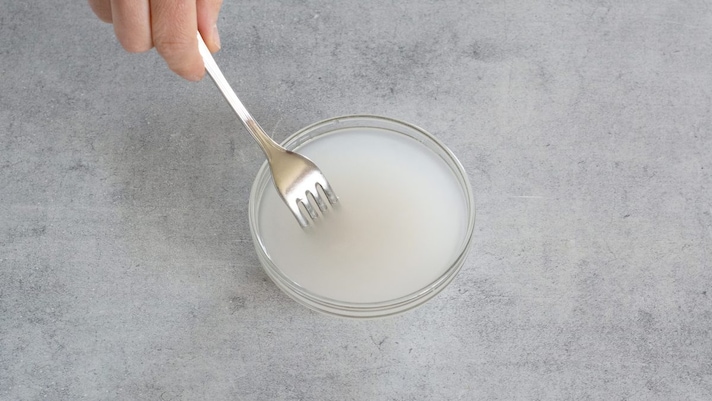
Mix with a fork to dissolve completely.
Mix with a fork to dissolve completely.
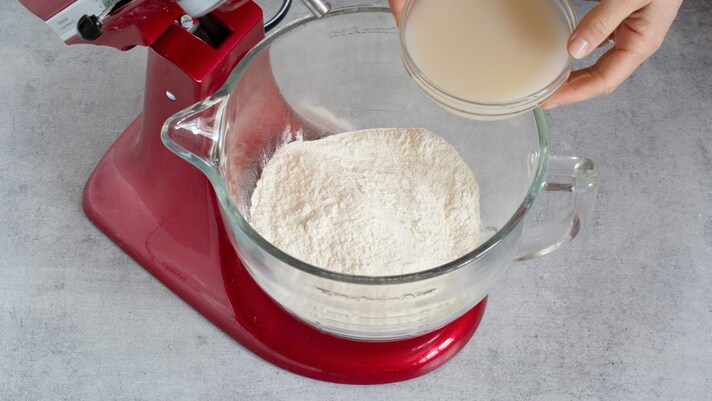
Pour the sifted flour and the yeast, dissolved in the water, into the bowl of a stand mixer fitted with a hook.
Pour the sifted flour and the yeast, dissolved in the water, into the bowl of a stand mixer fitted with a hook.
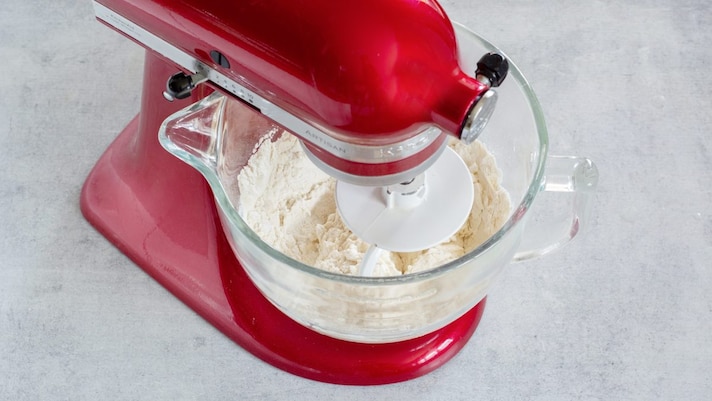
Mix all the ingredients well, at medium-low speed.
Mix all the ingredients well, at medium-low speed.
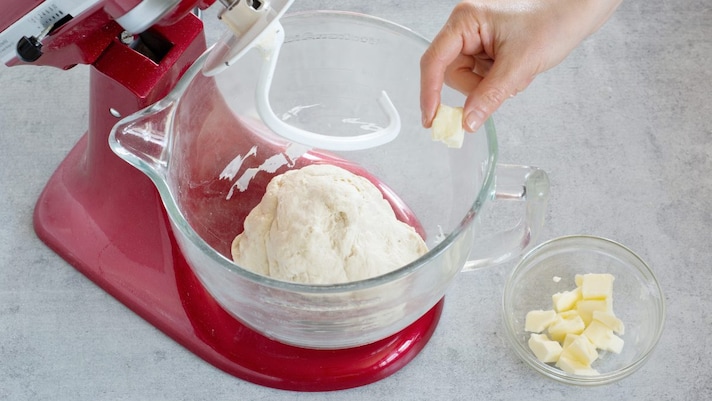
Once you have obtained a smooth and homogeneous mixture, gradually add the butter softened at room temperature, making sure that it is completely absorbed before adding more, keeping the mixer at the same speed.
Once you have obtained a smooth and homogeneous mixture, gradually add the butter softened at room temperature, making sure that it is completely absorbed before adding more, keeping the mixer at the same speed.
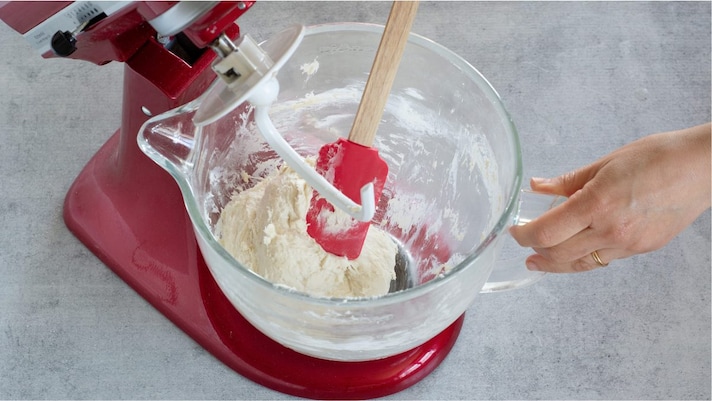
Once all the butter has been added, turn the dough over with a spatula and turn the mixer on for a few more minutes.
Once all the butter has been added, turn the dough over with a spatula and turn the mixer on for a few more minutes.
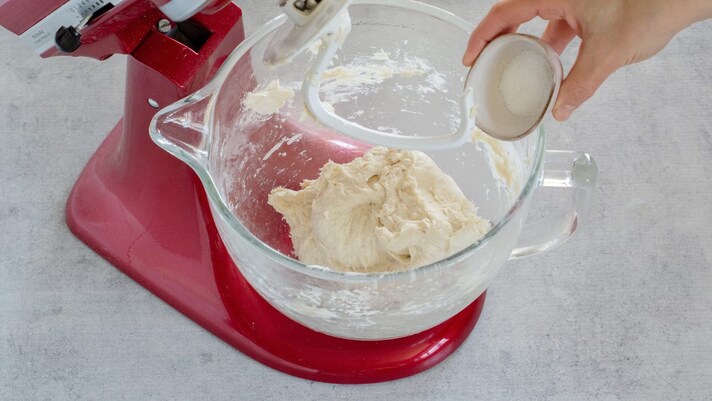
Add the salt and start the mixer again at medium speed.
Add the salt and start the mixer again at medium speed.
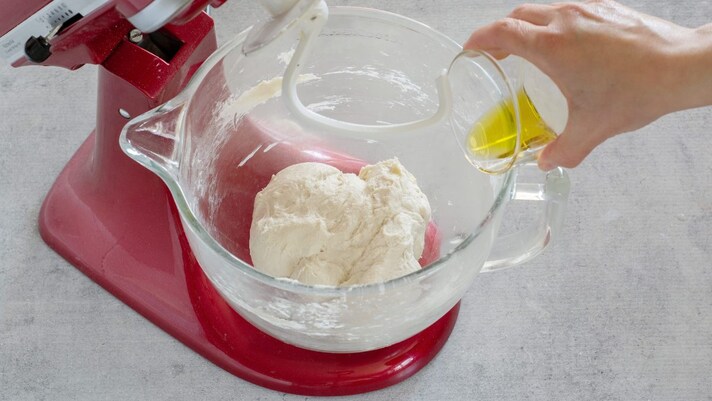
Add the oil too and work the dough for about ten minutes.
Add the oil too and work the dough for about ten minutes.
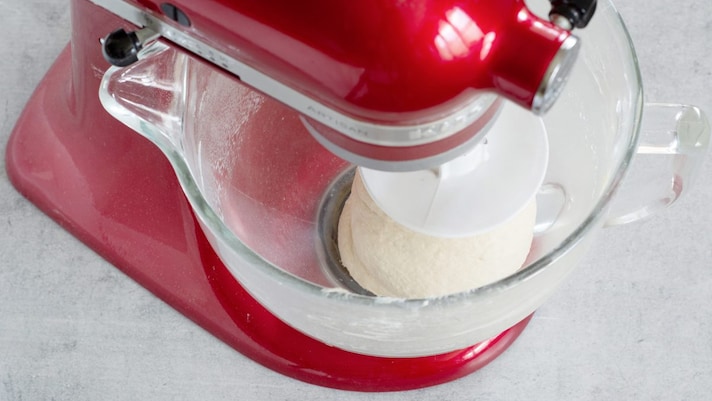
The dough will be ready when it comes away from the edges of the bowl and is well-strung on the hook.
The dough will be ready when it comes away from the edges of the bowl and is well-strung on the hook.
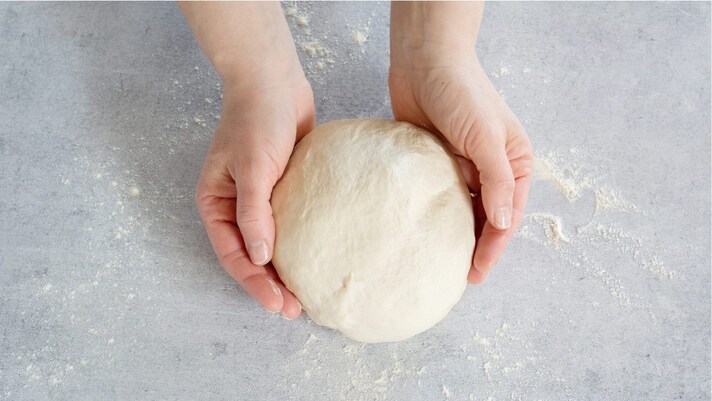
Pour the resulting dough onto a lightly floured pastry board and work it quickly to give it the shape of a ball.
Pour the resulting dough onto a lightly floured pastry board and work it quickly to give it the shape of a ball.
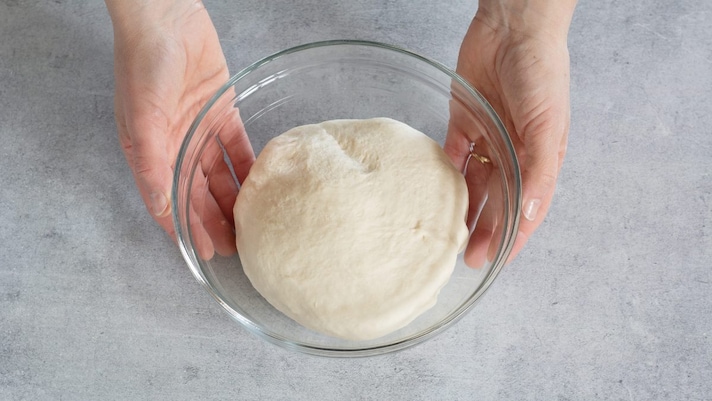
Transfer the ball into a bowl, cover with cling film and leave to rise at room temperature, away from drafts, for approximately 2 hours.
Transfer the ball into a bowl, cover with cling film and leave to rise at room temperature, away from drafts, for approximately 2 hours.
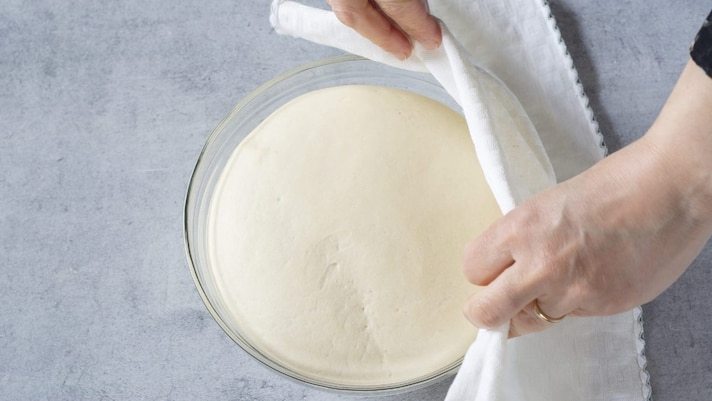
At the end of the leavening, the dough should have doubled in volume.
At the end of the leavening, the dough should have doubled in volume.
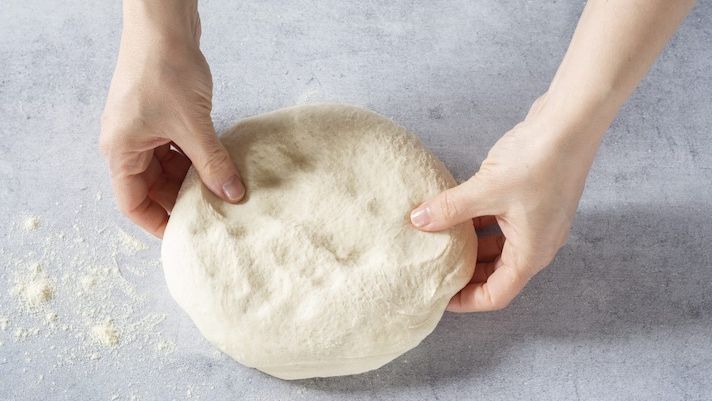
Then transfer the rising dough onto a lightly floured work surface.
Then transfer the rising dough onto a lightly floured work surface.
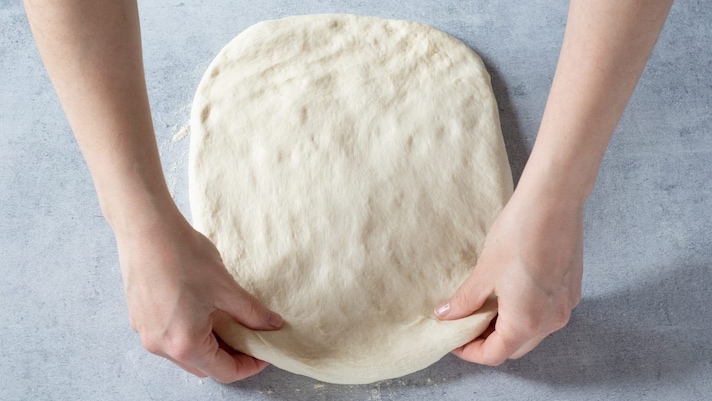
Gently roll out the dough with your hands until it forms a rectangle 24-25 cm long.
Gently roll out the dough with your hands until it forms a rectangle 24-25 cm long.
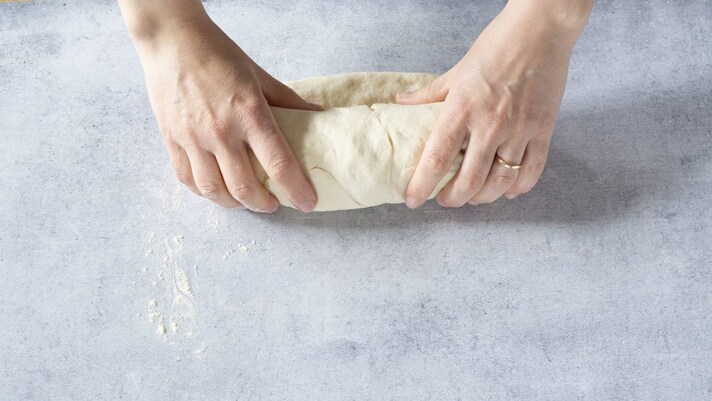
Then roll it up on itself to obtain a small loaf.
Then roll it up on itself to obtain a small loaf.
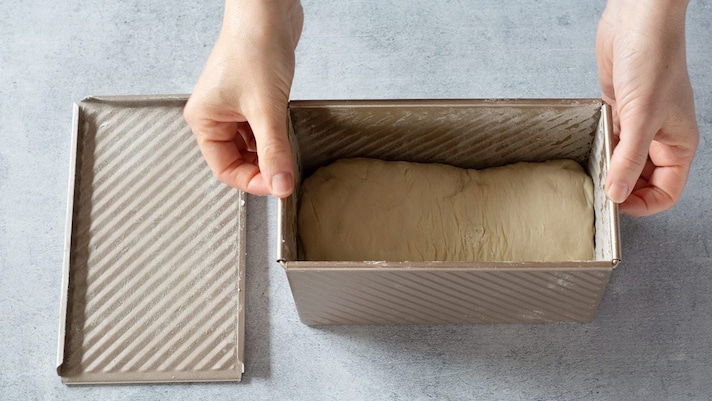
Place the loaf in a 25x10 cm buttered and floured loaf pan.
Place the loaf in a 25×10 cm buttered and floured loaf pan.
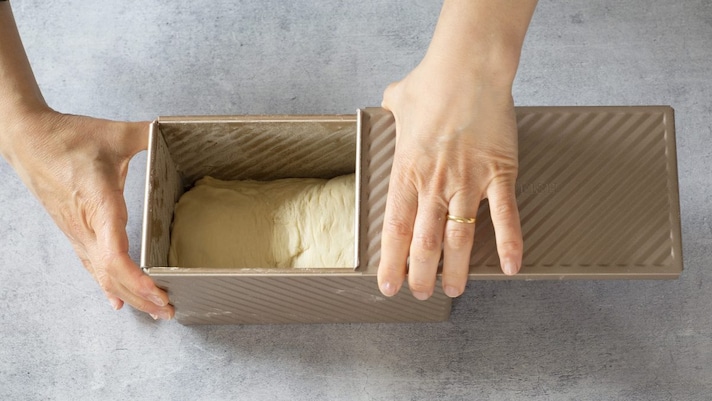
Cover with the lid and let it rise at room temperature for about 90 minutes.
Cover with the lid and let it rise at room temperature for about 90 minutes.

When the dough has reached the edge of the mold, bake it at 374°F (190°C), in static mode, for approximately 45 minutes.
When the dough has reached the edge of the mold, bake it at 374°F (190°C), in static mode, for approximately 45 minutes.
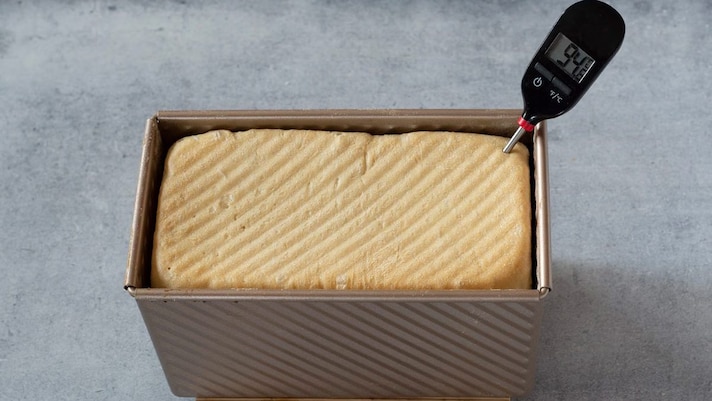
The bread will be cooked when its core has reached a temperature between 201-204°F (94-96°C), measurable with a needle kitchen thermometer.
The bread will be cooked when its core has reached a temperature between 201-204°F (94-96°C), measurable with a needle kitchen thermometer.
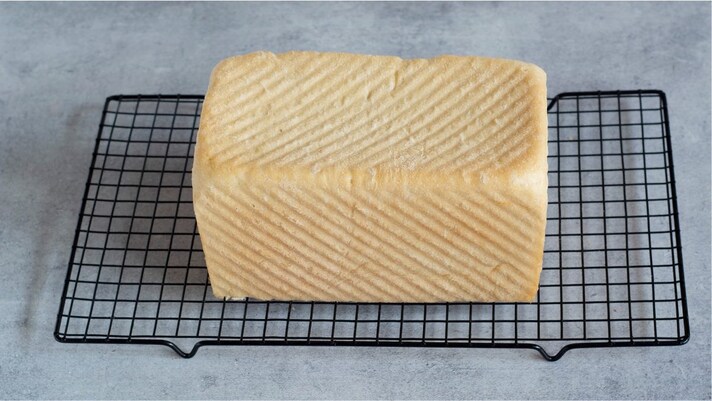
Once cooked, take it out of the oven and leave it to cool on a rack.
Once cooked, take it out of the oven and leave it to cool on a rack.
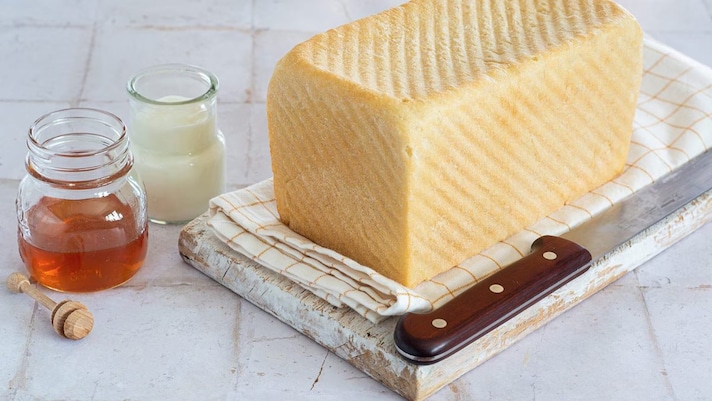
Your sandwich bread is ready. Enjoy!
Your sandwich bread is ready. Enjoy!
;Resize,width=767;)
;Resize,width=712;)
;Resize,width=712;)

